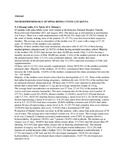Neuroepidemiology Of Spina Bifida Cystica In Kenya

View/
Date
2013-06Author
Mwang'ombe, NJ
Njiru, S G
Thiong'o, M G
Type
PresentationLanguage
enMetadata
Show full item recordAbstract
65 patients with spina bifida cystic were treated at the Kenyatta National Hospital,
Nairobi, Kenya between September 2011 and August 2012. The mean age at
presentation at presentation was 9 days. There was a male preponderance with
40 (61.5%) males and 25 (38.5%) female. In the order of family ranking most of
the patients (31, 47.7%) were first born in their respective families. The average
year at conception of the mother was 25.1 years with a range of 17-45 years. 55
(84.6%) of the mothers were married.
Majority of these mothers had some elementary education with 41 (63.1%) of
them having attained primary education and 12 (18.5%) of them having attended
secondary school. Majority of the mothers (50, 76.9%) had income less than
10,000 per month. Only 3 (4.6%) having a monthly income in excess of Ksh.
40,000 per month. 3 (4.6) of the mothers partook of alcohol in the prenatal period.
Only 2 (3.1%) were confirmed diabetic. One mother had taken anticonvulsants
in the prenatal period. Of note only 12 (18%) expressed awareness of folic acid
supplementation.
Of these only 8 (12.3%) were actually supplemented. About 50(76.9%) of
the mothers attended antenatal clinic. Majority of the mothers, 35 (53.8%),
commenced their clinic attendance between the 4-6th months. 13(20%) of the
mothers commenced the clinic attendance between the 1st – 3rd month.
Majority of the mothers were found to have had low haemoglobin of 11.1%. None
of the mothers had alpha fetoproteins tested during pregnancy. Additionally only
12(18.5%) of the mothers had an antenatal obstetric ultrasound done. Of these
only 4 (33%) were reported as abnormal.The infants had a mean birth weight of
3.1 kg and an average admission weight of 3.4 kg.
The average head circumference on admission was 37.3cm. 27 (41.5%) of the
patients had convex and tense anterior fontanelles. The most common sites for
the lesion were Lumbar 18 (27.7%), lumbo-sacral 20 (30.8%), thoraco-lumbar 13
(20.0%), sacral 9 (13.8%)and thoracic with 5 (7.7%). 36(55.4%) had hip flexion
representing a motor level of L3, 24 (36.9%) had knee flexion representing a
motor level also L3. 4 (6.2%) had ankle dorsi-flexion representing a motor level
at L5. 22 (33.8%) had knee extension, 26(40%) had hip extension and 3(4.6%)
had ankle plantar flexion all representing a motor level at S1. 31 (47.7%) had
complete skin cover whereas 33(50.8%) had incomplete skin cover. 7(10.8%)
had a documented CSF leak.
Evaluation of bladder function was done in all the patients, with a mean leak
point pressure of 34 cm of water. The average post void residual volume was 19
cc of water. The average serum urea level was 2.2mmol/l. Common associated
malformations were CTEV 42 patients (64.6%), hydrocephalus, 20 patients
(30.8%), and 7 patients (10.8%) with kyphosis. The median age at surgery was
15 days. 39(60%) had spina bifida closure alone, 9 (13.8%) had SB closure then
VP shunting. 9(13.8%) had spina bifida closure and vp shunting simultaneously.
The median duration of surgery was 56 min. 23(21.5%) developed wound
dehiscence, 12(11.2%) had features of wound necrosis while a further 12(11.2%)
had concomitant wound infection. 5 (7.7%) developed a CSF leak and 4(6.2%)
developed meningitis. 19(29.2%) developed hydrocephalus. 2(3.1%) developed
shunt related complications. 31(47.7%) developed post operative fever.
The cost burden to the family in terms of transport and care was in excess of
ksh. 45,000 per patient over the 30 day period of follow up in a majority of the
cases. In this paper, these findings are compared with those of a study done at the
same institution in 2004 by the senior author, and those from the rest of Africa.
The challenges encountered in the management of this condition in sub-Saharan
Africa is discussed.
Citation
N J Mwang’ombe, S G Njiru, M G Thiong’o,Neuroepidemiology Of Spina Bifida Cystica In Kenya,presented at the 2nd International Scientific Conference, Chs And Knh, 19th - 21st June 2013.Publisher
University of Nairobi College of Health Sciences
Description
Neuroepidemiology Of Spina Bifida Cystica In Kenya,presented at the 2nd International Scientific Conference, CHS And KNH, 19th - 21st June 2013.
